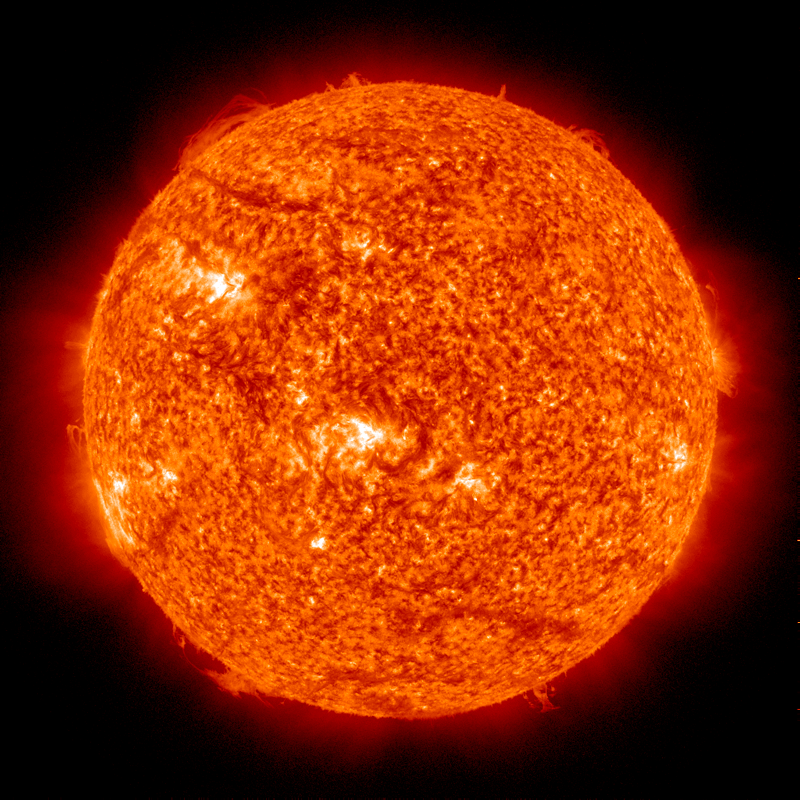CAUSE OF SUN APPEARING LARGER WHEN RISING AND SETTING THAN AT NOONDAY.
It is well known that when a light of any kind shines through a dense medium it appears larger, or rather gives a greater "glare," at a given distance than when it is seen through a lighter medium. This is more remarkable when the medium holds aqueous particles or vapour in solution, as in a damp or foggy atmosphere.
This part is trying to ignore the fact that the Sun's surface configuration is visible through adequate filters, including sun spots, solar flares and details in corona.
That is also how we know that Sun spins at rate of one rotation every 24 days.
Anyone may be satisfied of this by standing within a few yards of an ordinary street lamp, and noticing the size of the flame;
Look at burning gas lamp or candle, and you will see different features of the flame.


Now step away and look at it through light fog to enlarge glare around, and you will lose flame features in blur.
You will see only bright spot of certain size.
However, on a clear night, without that light fog, you will see details of the flame, but the apparent size will get reduced with distance.
Even the best camera has dynamic range much narrower than human eye and can add glare where eye won't see it.
on going away to many times the distance, the light or "glare" upon the atmosphere will appear considerably larger. This phenomenon may be noticed, to a greater or less degree, at all times; but when the air is moist and vapoury it is more intense.
With water droplets in the atmosphere we will have larger glare but no flame features, as we already established.
Obviously, there is no magnification, there's only diffusion when conditions allow it.
And they don't always, as we will see.
With glare we have blur.
Without blur we don't have glare.
It is evident that at sunrise, and at sunset, the sun's light must shine through a greater length of atmospheric air than at mid-day; besides which, the air near the earth is both more dense, and holds more watery particles in solution, than the higher strata through which the sun shines at noonday; and hence the light must be dilated or magnified, as well as modified in colour. The following diagram, fig. 66, will show also that, as the sun recedes from the meridian, over a plane surface, the light, as it strikes the atmosphere, must give a larger disc.
About one hour or less before sunset (or after sunrise) there are days with glare (light fog or thin clouds) and days without glare when all the Sun features could be clearly visible through proper filters.
Glare around doesn't enlarge details, can only blur them due to diffusion.

Fig. 66.
Let A, B, represent the upper stratum of the atmosphere; C, D, the surface of the earth; and 1, 2, 3, 4, 5, the sun, in his morning, forenoon, noon, afternoon, and evening positions. It is evident that when he is in the position 1, the disc of light projected upon the atmosphere at 6, is considerably larger than the disc projected from the forenoon position, 2, upon the atmosphere at 7; and the disc at 7 is larger than that formed at 8, when the sun, at 3, is on the meridian; when at 4, the disc at 9 is again larger; and when at 5, or in the evening, the disc at 10 is again as large as at 6, or the morning position. It is evident that the above results are what must of necessity occur if the sun's path, the line of atmosphere, and the earth's surface, are parallel and horizontal lines. That such results do constantly occur is a matter of everyday observation; and we may logically deduce front it a striking argument against the rotundity of the earth, and in favour of the contrary conclusion, that it is horizontal. The atmosphere surrounding a globe would not permit of anything like the same degree of enlargement of the sun when rising and setting, as we daily see in nature.
As presented in the Fig. 66, Sun at position 3 would have greater angular diameter than Sun at position 1.
Projection at position 8 is no greater than Sun at position 3.
Projection at position 6 may be stretched into elliptical form, and it may have one axis greater than Sun axis at position 1,
but by the observer it is seen under some sharp angle and that longer axis is reduced by cosine of the obserbing angle.
Seen from the observer can't be bigger than the angular size of Sun itself, which is seen by edge-seeing lines.
Glare around it can add more light, but it won't enlarge Sun.
On a clear day (with visible corona, solar flares and sun spots) the Sun disc itself would be visibly smaller if the distance to Sun was considerably changed.
Last photo was taken at 16:45 (4:45pm), just a little over one hour before sunset, similar to position 5 in Fig. 66.



